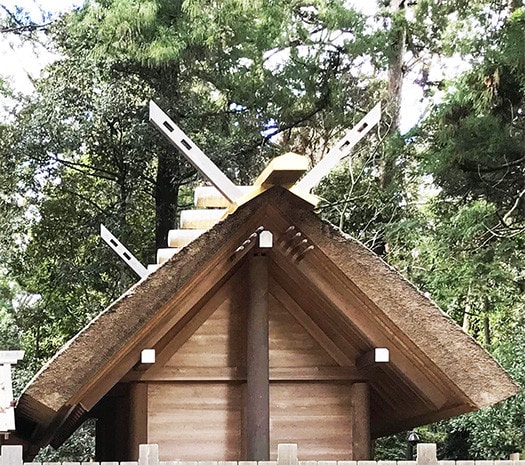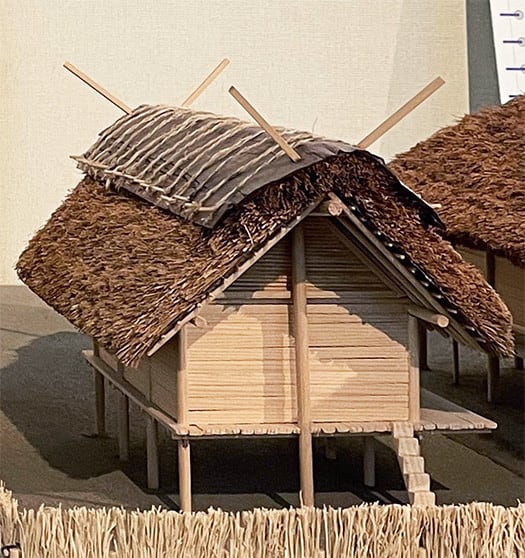


「三木さん、なぜか奈良にスピンアウトしてる」と北海道内の方からご意見。
一方で奈良・橿原在住の方からは、貴重な建築資料も送付いただいた。
北海道人からすると奈良ははるかな遠隔地、
また奈良県人からすると北海道は縁もゆかりもなさそう。
っていうことですが、わたし的には建築探訪としては原初と現代。
どっちも深くとらわれる対象であります。
さて奈良県内でもややフェッチっぽい纏向遺跡。
WEBで調査してみたら、2014年9月20日に東京新聞フォーラム
「よみがえる古代の大和神社建築の源流
-纒向(まきむく)から飛鳥の宮殿まで-」催事の記録記事発掘。
東京新聞と奈良県立橿原考古学研究所主催の東京新聞フォーラムが
8月30日東京都墨田区の江戸東京博物館で開かれたということ。
時系列としてはわたしははるかな後追い、追っかけをしている(笑)。
で、その記事中で神戸大学の黒田龍二教授による「纒向遺跡の王宮と
その後の神社・居館・宮殿」と題した基調講演の記録があった。
以下、要旨の引用であります。
〜奈良県の纒向遺跡は3世紀の遺跡で邪馬台国との関連が議論されるが、
後の日本の歴史を考えるとヤマト王権発祥の地と考えられることが最も重要。
纒向遺跡で発見された建物群は初期ヤマト王権の王宮といえる。
纒向遺跡は現代まで続く日本国家の誕生の地であり、2009年の王宮の発掘は
わが国の歴史上最大級の価値を持つ発見である。
全体の配置に明らかな設計意図が見られる点で王権にふさわしい建物群。
纒向遺跡の建物を考察すると「神社と宮殿」の原型が見いだせる。
つまり遺跡と日本書紀、古事記の記述から伊勢神宮との関係が推定される。〜
ということが提起されています。
わたしがこの復元模型・棟持ち柱建築(下の写真)を見たとき、
「伊勢そっくり」(写真上は伊勢外宮殿舎)と思ったのはごく自然だった。
〜日本書紀をみると、王宮では崇神天皇が天照大神の御霊代を祀っていた。
天皇は御殿で「同床共殿」祭祀を行っていたが神の霊威を怖れ、宮内の大庭に
ホコラを建て大神ご神体である宝鏡をお納めした。これが建物C(下写真)。
それでもまだ怖れ多いので垂仁天皇の時代に伊勢に社を造り宝鏡をお移しした。
それが伊勢神宮であり建物Cの復元形態は神宮の正殿と極めてよく似ている。
神明造の形が倉庫と近いのは建物Cが王宮での宝庫だったことによる。
纒向遺跡の建物Cは伊勢神宮の直接の起源。〜という解説。
おお、でありますね。
伊勢ではこの社を式年遷宮で建て替え続けてきたけれど、
その初源はこの纏向遺跡にあったと結論づけられている。
わたし的にはこうした考古発掘事実と重ねれば客観的事実と考え得る。
2世紀末〜3世紀が神話から「歴史」化してくると思えますね。
English version⬇
The Mata Makimuku is the root of the Ise Jingu Shrine.
The Geku temple building with mune-hattori pillars to be relocated during the Ise Jingu Shikinen. The roots of the temple building are the residence buildings at the site of the Makimuku. The archaeological excavation facts and the Kikki tradition are clearly consistent. The origin of the building is the Makimuku site.
A person in Hokkaido commented, "Mr. Miki, for some reason you are spinning out to Nara.
On the other hand, a resident of Kashihara, Nara, sent us some valuable architectural materials.
From the point of view of a person from Hokkaido, Nara is a far remote place.
And from the point of view of people from Nara Prefecture, Hokkaido seems to have no connection with Nara.
But for me, architectural exploration is about the primitive and the modern.
I am deeply fascinated by both.
The Sumamukai ruins seem to be a bit of a fetish even within Nara Prefecture.
I found a web-based article on the Tokyo Shimbun Forum on September 20, 2014.
Reviving the Origins of Ancient Yamato Shrine Architecture
-The Tokyo Shimbun Forum "Reviving the Origins of Ancient Yamato Shrine Architecture: From Makimuku to Asuka's Palace" was held on September 20, 2014.
The Tokyo Shimbun Forum, sponsored by the Tokyo Shimbun and the Archaeological Institute of Kashihara, Nara Prefecture, was held on
The Tokyo Shimbun Forum was held at the Edo-Tokyo Museum in Sumida-ku, Tokyo, on August 30.
I have been following the event as far as the timeline is concerned (laugh).
In the article, Professor Ryuji Kuroda of Kobe University wrote "The Royal Palace of the Garatsuki Ruins and Its Subsequent Shrines, Residences, and Palaces.
The following is a quotation from the abstract.
The following is a quote from the abstract.
〜The 3rd century ruins of the Garumukai site in Nara Prefecture have been discussed in relation to the Yamataikoku Kingdom.
However, the most important thing is that it is considered to be the birthplace of the Yamato kingdom, considering the later history of Japan.
The buildings discovered at the Makimuku site can be considered the royal palace of the early Yamato kingdom.
The 2009 excavation of the royal palace is one of the largest and most valuable excavations in our country's history.
The 2009 discovery of the palace is one of the most valuable discoveries in the history of Japan.
The buildings are appropriate for royalty in that their overall layout shows clear design intent.
The buildings at the Makimuku site are the prototype of "shrines and palaces".
In other words, the relationship between the ruins and the Ise Shrine can be inferred from the descriptions in the Nihonshoki and Kojiki. 〜˜
This is what is being proposed.
When I saw the restored model of the mune-haruhashibashira structure (photo below), I thought it looked "just like Ise" (photo above).
When I saw this model, I naturally thought that it looked just like Ise (the upper photo is the outer palace building of Ise).
〜According to the Chronicles of Japan, Emperor Sojin enshrined the Imperial reign of Amaterasu at the Oomiya Palace.
The emperor was performing the "Doyokotoden" ritual in the palace, but he was afraid of the deity's authority, so he built a hokorah in the palace's main courtyard.
The emperor was afraid of the divine authority, so he built a hokorah in the palace's main garden to house a mirror, which was the sacred object of the deity. This is Building C (photo below).
Still, the people were still afraid of the god, so a shrine was built in Ise during the reign of Emperor Taruhito, and the mirror was moved to the shrine.
This was the Ise Jingu Shrine, and the restored form of Building C is very similar to the Shoden of the Jingu Shrine.
The reason why the Shinmei-zukuri is similar to a warehouse is that Building C was a storehouse of treasures in the royal palace.
Building C at the Makimuku site is the direct origin of Ise Jingu. 〜The explanation is as follows.
Oh, yes.
Ise has been continuously rebuilding this shrine during the annual shikinen-sengu ceremony.
Ise has continued to rebuild this shrine during the annual relocation ceremonies, and it has been concluded that the origin of the shrine was this Makimuku site.
In my opinion, this is an objective fact when combined with such archaeological excavation facts.
I think that the end of the 2nd century to the 3rd century will be the beginning of the transition from myth to history.



















